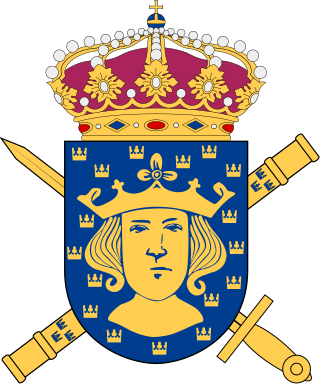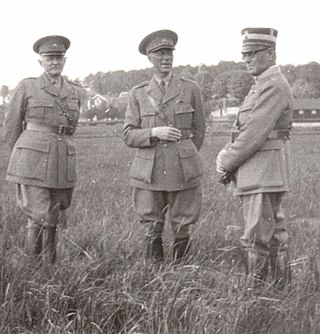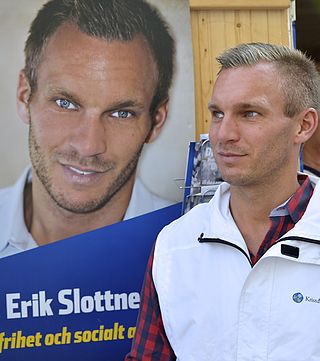
The Quartermaster-General of the Swedish Army [1] (Swedish : generalintendenten, genint) was a general officer who was responsible for the Swedish Army Quartermaster Corps, the quartermaster branch of the Swedish Army.

The Quartermaster-General of the Swedish Army [1] (Swedish : generalintendenten, genint) was a general officer who was responsible for the Swedish Army Quartermaster Corps, the quartermaster branch of the Swedish Army.
In Sweden, the Quartermaster General was the highest commander of an army's commissariat service; between 1796 and 1814 it was the name of the chief of the General War Commissariat (Generalkrigskommissariatet), and between 1850 and 1865 the name of the chief of the Commissary Department in the War College, and finally from 1865 the name of the chief of the Royal Swedish Army Materiel Administration's Quartermaster Department (from 1880 also head of the Swedish Army Quartermaster Corps). [2] The Quartermaster General was responsible for the army's clothing and provisioning, maintenance and remounting, in war also for the General Staff's finances and the accounting thereof. [3]
The Quartermaster General, who commanded the Swedish Army Quartermaster Corps, also commanded the Royal Swedish Army Materiel Administration's Quartermasters Department and he was also, from 1914, the Inspector of the Quartermaster Service Troops (Intendenturtrupperna, Int) and regarding the training of these troops, he had similar duties as other branch inspectors. In his capacity as head of the Swedish Army Quartermaster Corps and Inspector of the Quartermaster Service Troops, he was assisted most closely by personnel of the Quartermaster Staff (Intendenturstaben). [4]
In the Swedish Navy, in 1789, a Quartermaster General was appointed, in whose hand the entire economic board rested. The office was abolished in 1794. [5]
| Portrait | Quartermaster General | Took office | Left office | Time in office | Defence branch | Monarch | Ref. |
|---|---|---|---|---|---|---|---|
| Johan Peter af Billbergh (1776–1850) Acting | 14 July 1812 | ? | 0 years | – | Charles XIII | [6] | |
| Lieutenant colonel [lower-alpha 1] Gösta Sandels (1815–1914) Acting | 1853 | 1858 | 4–5 years |  Army | Oscar I Charles XV | [8] [7] | |
| Lieutenant general [lower-alpha 2] Gösta Sandels (1815–1914) | 1858 | 1883 | 24–25 years |  Army | Oscar I Charles XV Oscar II | [8] | |
| Major general [lower-alpha 3] Hjalmar Palmstierna (1836–1909) | 26 February 1883 | 1892 | 8–9 years |  Army | Oscar II | [9] | |
| Colonel Christer Oxehufvud (1831–1917) Acting | 15 March 1889 | 1890 | 0–1 years |  Army | Oscar II | [10] | |
| Major general Adam Thorén (1835–1907) | 1892 | 1896 | 3–4 years |  Army | Oscar II | - | |
| Major general Richard Berg (1843–1924) | 13 November 1896 | 1904 | 7–8 years |  Army | Oscar II | [11] | |
| Major general Knut Gillis Bildt (1854–1927) | 29 January 1904 | 1905 | 0–1 years |  Army | Oscar II | [12] | |
| Fredrik Holmquist (1847–1927) | 3 November 1905 | 10 April 1915 | 9 years, 158 days |  Army | Oscar II Gustaf V | [13] | |
| Major general Fredrik Frölich (1861–1933) | 10 April 1915 | 1926 | 10–11 years |  Army | Gustaf V | [14] | |
| Lieutenant general [lower-alpha 4] Axel Hultkrantz (1870–1955) | 1 November 1926 | 11 April 1935 | 8 years, 161 days |  Army | Gustaf V | [15] | |
| Major general Helge Söderbom (1881–1975) | 1935 | 1946 | 10–11 years |  Army | Gustaf V | [16] | |
| Major general Ivar Gewert (1891–1971) | 1946 | 1957 | 10–11 years |  Army | Gustaf V Gustaf VI Adolf | [17] | |
| Major general Hilding Kring (1899–1971) | 1 April 1957 | 30 June 1963 | 6 years, 90 days |  Army | Gustaf VI Adolf | [18] |
The Governor of Stockholm was the head of the Office of the Governor of Stockholm, and as such he was the highest Swedish State official overseeing the affairs in the City of Stockholm between 1634 and 1967. The Governor was the equivalent in Stockholm of a county governor elsewhere in Sweden.
Admiral (Adm) (Swedish: Amiral, Am) is a four-star commissioned naval officer rank in the Swedish Navy. Admiral ranks immediately above vice admiral and is equivalent to general.

The Chief of Army is the most senior appointment in the Swedish Army. The position Chief of Army was introduced in 1937 and the current form in 2014.

The Surgeon-General of the Swedish Armed Forces is the highest-ranking medical officer of the Swedish Armed Forces. The Surgeon-General is responsible for the supervision of the Swedish Armed Forces, the Defence Materiel Administration, the Swedish Fortifications Agency and the National Defence Radio Establishment. This includes supervision in the areas of environment, health, nature, sewage, waste and chemicals.

The Commandant General in Stockholm is a military position in Sweden with responsibility for state ceremonial activities. Lieutenant General Michael Claesson, Chief of Defence Staff is the Commandant General in Stockholm since 2020.
The Master-General of the Ordnance was the title of a senior military official who was an artillery general and at times head of the Royal Swedish Army Materiel Administration's Artillery Department and artillery inspector. The Master-General of the Ordnance held a pivotal role from the 17th to the late 19th century, overseeing artillery administration, procurement, and maintenance. Originally known as the Riksfälttygsmästare, this position evolved to manage the Artillery Office and later the Ordnance Department of the Royal Swedish Army Materiel Administration. Until 1898, the Master-General also supervised the Swedish Artillery, but organizational changes then placed artillery units under division chiefs, while the Master-General retained authority over key artillery functions. Responsibilities included inspecting artillery exercises and overseeing weapon development, production, and equipment maintenance. The role was eventually split into separate appointments in 1937, with the Master-General heading the Swedish Army Ordnance Corps until its dissolution in 1968.

The Chief of the Defence Staff is the second most senior uniformed member of the Swedish Armed Forces and heads the Defence Staff. The Chief of the Defence Staff is the chief of staff of the Supreme Commander of the Swedish Armed Forces.

The Deputy Chief of Ordnance was in Sweden the head of the Swedish Army's ordnance establishments. During the 1800s and 1900s, his duties changed several times. The position was abolished in 1968.

Lieutenant General Peder Adolf Ludvig Regnell Hammarskiöld was a Swedish Army officer. Hammarskiöld's senior commands include commanding officer of the 2nd Army Division and the Eastern Army Division, the position of Commandant General of Stockholm Garrison, Master-General of the Ordnance and Inspector of the Artillery. As a military historian, he researched the ancient history of the Swedish artillery.

The Chief of the Army Staff is the professional head of the Swedish Army Staff. The post was created in 1936 with colonel Helge Jung as the first incumbent. The post disappeared in 1994 and was reintroduced in 2019 when the new Army Staff was established.

The Chief of the Naval Staff is the professional head of the Swedish Naval Staff. The post was created in 1907 with rear admiral Theodor Sandström as the first incumbent. The post disappeared in 1994 and was reintroduced in 2019 when the new Naval Staff was established.
Vice admiral is a three-star commissioned naval officer rank in the Swedish Navy. Vice admiral ranks above rear admiral and below admiral. Vice admiral is equivalent to the rank of lieutenant general.

The Minister for Civil Service Affairs, since 2010 called Minister for Public Administration, is a member of the Government of Sweden. The minister for civil service affairs was the head of the Ministry for Civil Service Affairs from 1840 to 1996. It was reintroduced as a minister without portfolio post in 2010. Its tasks includes government procurement and an overall responsibility for municipalities and regions.
{{cite book}}: CS1 maint: location missing publisher (link)